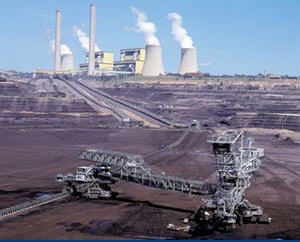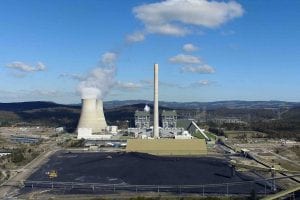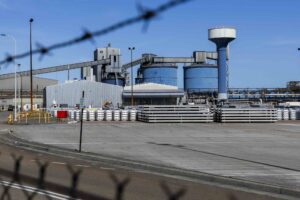AGL Energy, the biggest electricity generator in Australia, is reaping the rewards of its recent multi-billion dollar investment in large coal generators in Victoria, and the recent investment drought in wind and solar farms.
AGL Energy CEO Andy Vesey likes to joke that by the time he had been approached about the job, through to when he turned up to take the reins in 2015, AGL had morphed from what appeared to be a renewables-focused company to a major coal generator, the biggest in the country.
He’s probably thankful it is paying dividends to shareholders.
And how. In the last year, the price AGL received from wholesale markets nearly trebled – from $34/MWh to $83/MWh, according to Morgan Stanley.
That delivered a windfall gain for AGL, because 85 per cent of the electricity it generated came from its huge but ageing brown and black coal generators in Victoria and NSW and its average cost of generation was just $37/MWh.
This cost of $37/MWh was little changed from last year ($35/MWh) which might come as a surprise to all those consumers facing huge lifts in their energy bills because of a so-called surge in the cost of wholesale generation. They might wonder where the pricing regulators are, or have been.
(AGL owns the Loy Yang A brown coal generator in the Latrobe Valley, as well as the Bayswater and Liddell plants in the Hunter Valley. Liddell operated at a capacity factor of just 50 per cent, barely higher than some of the nation’s best wind farms, despite an increase in availability).
AGL Energy’s results came in just above analyst expectations, with underlying profits up 14 per cent to $802 million, and so too did its forecasts for the coming years. It expects a 20 per cent lift to $1 billion this financial year and analysts see a similar jump over the next year.
The other aspects of its accounts illustrate how AGL – like other gen-tailers – are able to profit from the way they influence policy, and can slice and dice earnings to their advantage, a key issue given the soaring consumer bills across the country.
Readers will remember that AGL, like other major retailers, went on an effective capital strike on renewable energy due to “policy uncertainty” as the Abbott government and the fossil fuel lobby sought first to kill and then finally reduce the scale of the renewable energy target.
That lack of investment in new wind and solar farms over three years did not just allow wholesale prices to go higher than they would otherwise be, they also led to a surge in the price of large-scale renewable energy certificates (LGCs).
AGL’s profits from eco-markets more than doubled in the last year, from $69 million to $141 million, reflecting the increased market price for LGCs, and the ability to use stored certificates bought previously at a lower price.
Now that the renewable investment drought is over, and something of a boom in wind and solar plants is finally taking place, AGL expects to the price of LGCs to ease. But it still won’t be able to meet its obligations over the next two years, so will likely have to buy on market.
The main topic of the week, however, has been consumer bills, and once again AGL has shown how it can slice and dice bills to preserve earnings.
It says that 80 per cent of its customers accessed discounts in the last year, but adds that this was “managed” so that its actual profits from sales to consumers increased over the year.
In the consumer division, returns rose to $485 million from $463 million, while the business customers increased from $35 million to $40 million. Overall, its margins per customer increased slightly to $217, although net margins fell because of the costs of investment in new markets such as W.A.
It underlines the fact that the main issue is that electricity prices are still too high, equivalent to relying on a diesel generator in the garage, and while big retailers may offer bigger discounts, their overall revenue from consumers is going up, even as volumes fall.
Vesey was asked if AGL and other utilities saw the industry going the same way as the banking sector, constantly pilloried from accusations of profiteering from consumers.
Vesey argued that the best way of dealing with the problem was to be strong financially. But he conceded that accusations around making big profits when consumers were being hit with big bills could be problematic, and said the solution lay in correct policy settings.
He said he was hopeful – after the meeting on Wednesday between him and other industry leaders and prime minister Malcolm Turnbull and energy minister Josh Frydenberg – that the government would finally commit to an energy security target.
But he underlined his oft-made point that investment in new coal plants was not economically rational, and neither was investing in existing plants to extend their life-span.
“The challenge is that we are at a point where the lack of certainty around carbon policy is preventing people from investing in the right options, which we thing is wind, solar, and storage,” Vesey said.
The biggest black spot on AGL’s profit accounts was the performance of the gas division, where AGL was hurt by the surging cost of domestic gas supplies.
It is looking to address that by building, ironically, a LNG import plant at the cost of $250 million, and announced that it is looking to site that at Crib Point, near Westernport in Victoria. It is also looking to invest $250 million expanding its Silver Springs gas storage facilities in Queensland.
It expects this new competition will result in Australian domestic gas prices being effectively capped at international prices, rather than being higher than them as they have been in the past year.
This came as rival Origin Energy was forced by falling international prices to announce a massive $1.2 billion write-down in the value of its domestic gas assets, including $815 million from its share of the Australia Pacific LNG (APLNG) project, and $357 million for the Lattice Energy conventional gas assets.
 AGL also announced it had increased its rehabilitation provisions by $69 million to $307 million, reflecting the present value of some $1.7 billion it expects to spend rehabilitating old coal plants and mines, and gas plants and other assets, over the next 60 years.
AGL also announced it had increased its rehabilitation provisions by $69 million to $307 million, reflecting the present value of some $1.7 billion it expects to spend rehabilitating old coal plants and mines, and gas plants and other assets, over the next 60 years.
The biggest cost will be Loy Yang ($261 million for real cash costs) which is less than the $439 million set aside by France’s Engie for just the mine rehabilitation at the now closed Hazelwood power plant.









